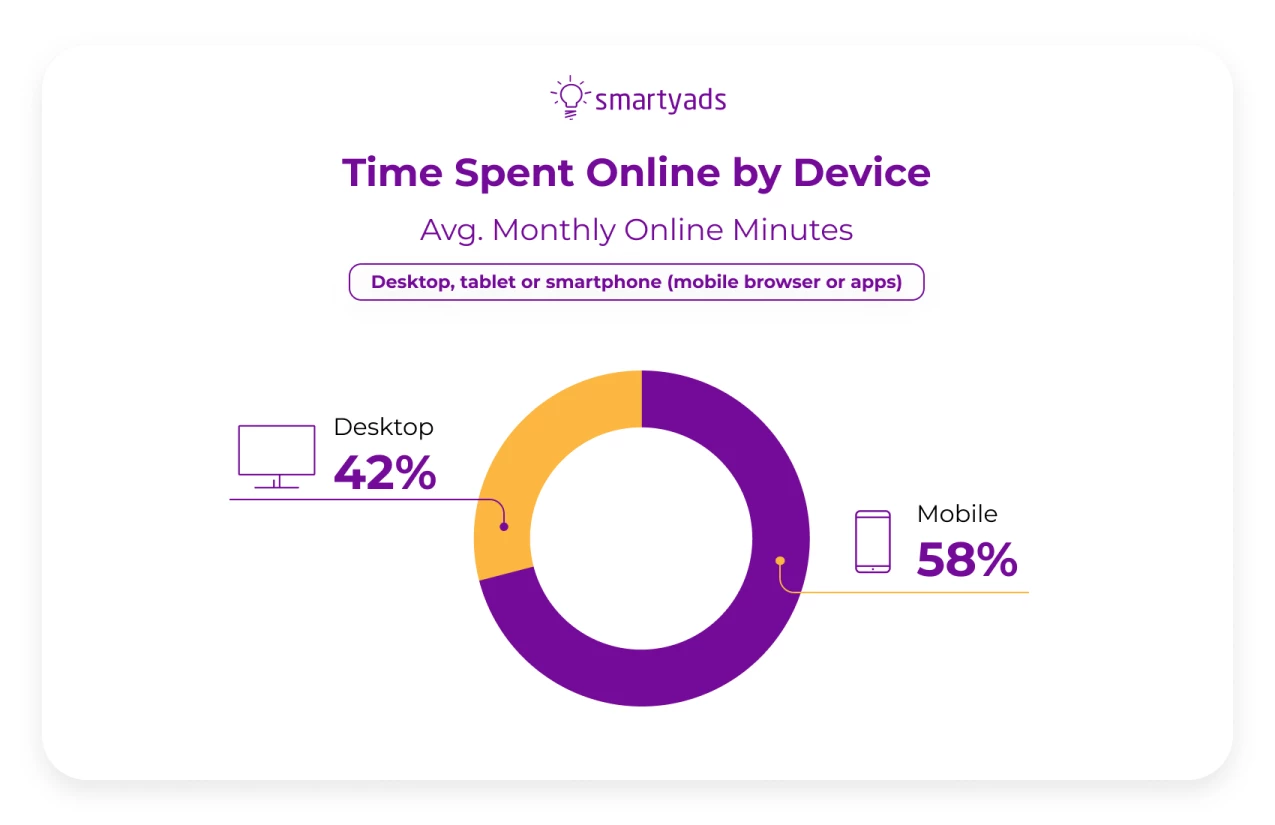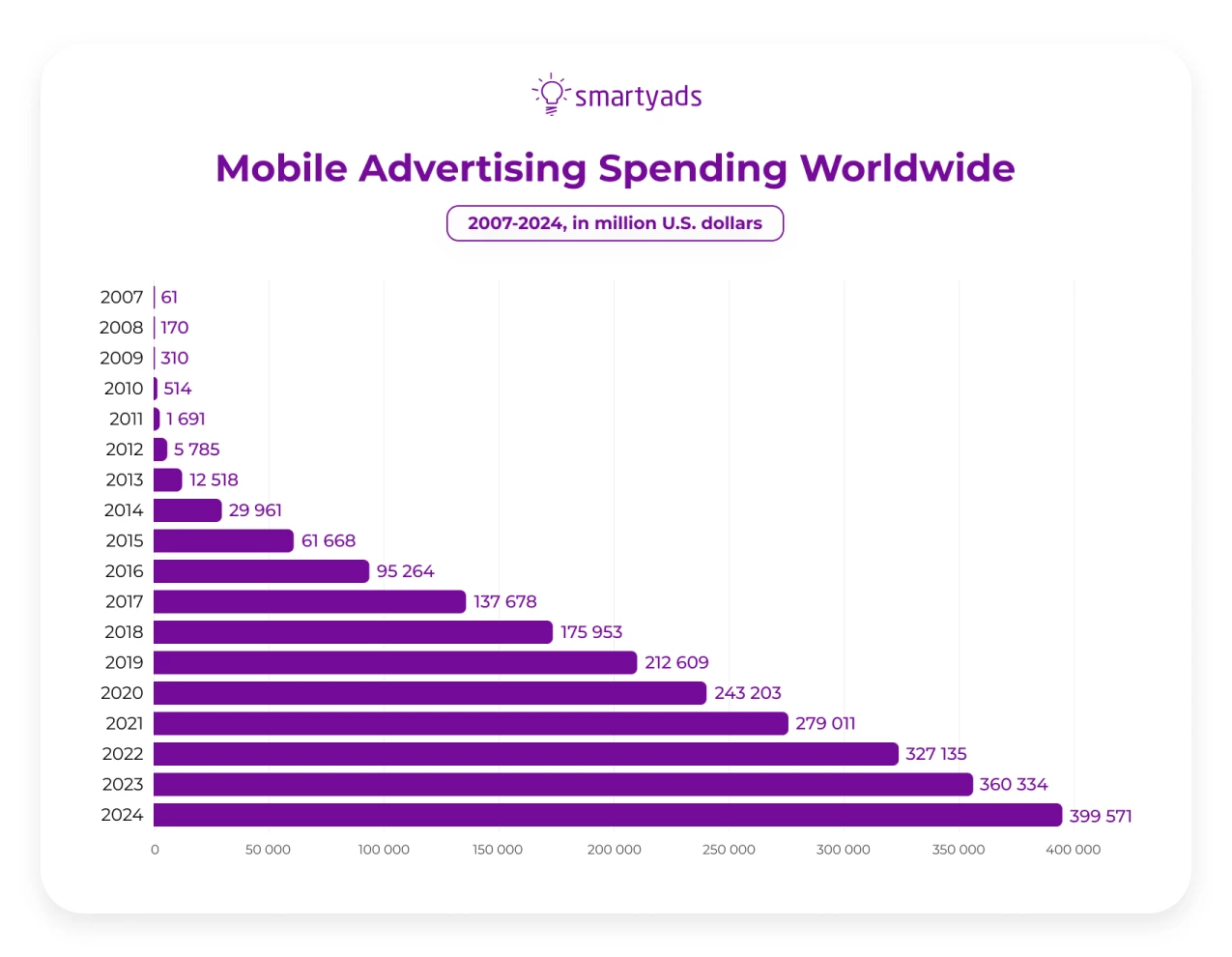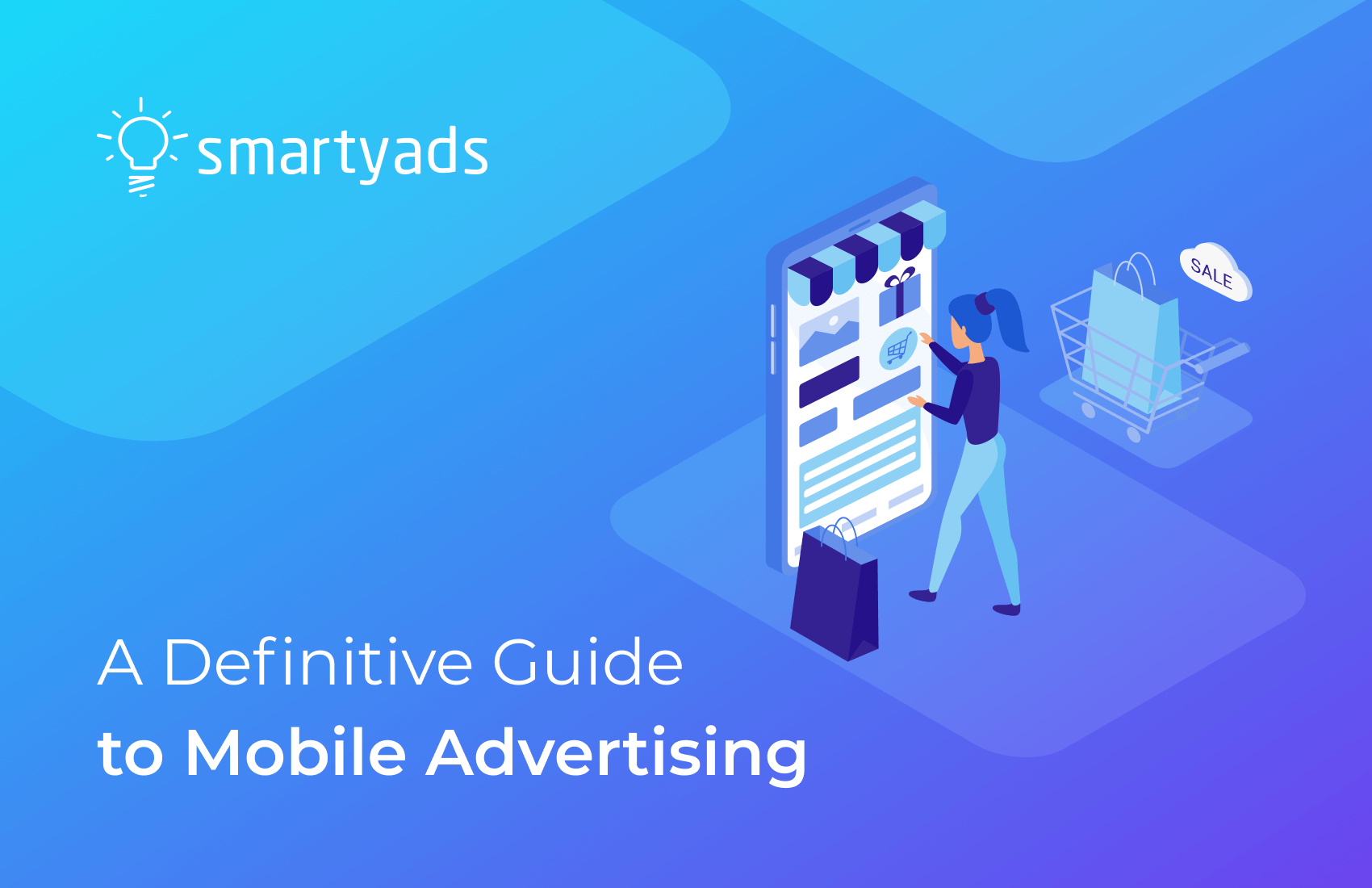Long gone are the days when display ads dominated the digital advertising industry. New formats emerged and advanced throughout recent decades while others remained to be short-lived. Mobile marketing grew particularly fast and eventually developed into a self-sufficient system. Now, this medium supports a variety of ads including banner ads, text messages, interactive and video ad formats, rich media ad formats, push notifications, in-app, and much more.
Mobile devices have been firmly rooted in the realm of digital marketing. On average, online users spend 6.4 hours browsing the internet per day. According to the most recent Statista report, 58% of all time spent online is attributed to mobile devices. Such a rising popularity of mobile is unprecedented. As this is the main focal point of marketers and advertisers, we have prepared an insightful guide to answer the fundamental question: What is mobile advertising and how does it work?

What is mobile advertising?
To begin with, let’s get familiar with the mobile advertising definition. Mobile advertising is a powerful marketing approach that consists of displaying promotional materials on mobile devices such as smartphones and tablets. Its primary goal lies in effectively reaching and converting the intended audience.

Differences between desktop and mobile advertising
How does mobile advertising work? Essentially, mobile advertising works similarly to display ads — it involves lots of techniques and data usage. One should still collect data and analyze their target audience persona in order to reach potential customers, just like with any programmatic advertising campaign.
However, there is still a significant difference between the two, since the mobile advertising ecosystem is mostly based on mobile apps. And because most apps are downloaded for free or are based on the freemium business model, developers are interested in monetizing them through ads.
Such a landscape leaves space for marketers to get creative and explore new formats and ad techniques. Besides, ad blockers are not so widely used within mobile digital advertising, so the potential losses from the issue are significantly lower when compared to desktop. Also, many types of ad fraud, which are often becoming such a big problem for desktop publishers, are impossible to perform on mobile devices. For instance, it is harder to impersonate clicks and impressions in a mobile environment.
There is also a significant difference between user intention in mobile and desktop environments. For example, 56% of mobile users search for products, and 52% compare prices weekly, while only 37% and 34% of desktop users perform these actions respectively. If you want to get the best results while building a programmatic ads strategy take these numbers into account.
7 mobile advertising benefits
In this section, we are going to explore what are the benefits that a mobile marketing campaign can bring to your business.
Accessibility
Mobile devices have become a significant part of our lives, as people can use them anywhere. Such accessibility works wonders for advertisers who can now communicate directly to each member of their audience and deliver their message in an instant.
Demographic diversity
You can now target users of almost any age or gender, socio-economic background, or ethnicity, even with different interests, and habits or levels of income. Users with all these characteristics can now be easily targeted in the mobile digital advertising landscape.
Creative options
Because there are so many formats and channels available for mobile marketing, creative options for your ads are only limited by the imagination. One can leverage mobile video ads, websites, social media, or apps. Each of these options has unique features and opportunities to play with design.
Cost efficiency
Mobile advertising is often regarded as the most budget-friendly option for advertisers. The overall cost of launching a mobile advertising campaign is far smaller than traditional radio or TV ads. Apart from this, tracking and optimizing your budget is much easier for mobile campaigns which gives you more control over your funds.
Personalization
The opportunity to make your messages personalized is one of the biggest benefits of mobile advertising for marketers. Consumers’ habits and preferences can be easily analyzed, thus, you can create a relevant mobile advertising campaign with these details in mind. With global reach and instant delivery, personalization can potentially make your campaigns remarkably efficient.
Targeting solutions
Having access to a wide range of data about your desired audience, it’s possible to set up detailed and precise targeting so only those who correspond to your requirements can view your ad campaigns. Also, advertisers can leverage the benefits of location-based advertising and combine it with other options, such as behavioral targeting.
More engagement
Mobile ads are getting more and more interactive. Users tend to enjoy interactive ads, such as rich media, as they allow them to explore a product from different perspectives before making a purchase. Some formats allow offering an incentive for user attention — for instance, rewarded video ad formats that are shown within a mobile app.
The current state and the future of mobile ads
Ever since the very introduction of mobile devices and the appearance of the first ads, the mobile advertising industry has been growing with each passing year, sometimes even doubling its global ad spend annually.
As the report from Statista shows, in just five years, mobile ad spending has grown almost two times — from $213 million in 2019 to a striking $400 million in 2024. It’s worth noting that the U.S. is the leading country in mobile ad spending, with an impressive annual figures surpassing $150 billion in 2023.

We can also observe the evolution of mobile digital advertising by analyzing the related industries, such as gaming. The numbers are quite impressive here as well — from 2019 to 2024 mobile games market revenue surged from $74 billion to $98 billion. What’s even more striking and promising, the indicator is estimated to reach almost $119 billion by 2027. Both TV, console, and desktop games showed a steady decline within the same period, leaving no questions about the future of mobile gaming unanswered.

The mobile advertising ecosystem
Just like connecting the dots of the programmatic ecosystem, connecting the elements into a working machine might seem complicated at first glance. However, in practice, a lot of things get immediately clear once you get a basic understanding of general elements and their role in the system.
Programmatic advertising is a process of automated media trading. It utilizes lots of various platforms, such as DSP, SSP, ad networks, etc. These platforms, in turn, work with different types of advertising display and search advertising, social media, video, connected TV, and mobile ads.
Demand-side platform (DSP) is a ‘buy-side’ programmatic software that allows advertisers to find the matching inventory and buy impressions from multiple sources for the best price, usually via real-time bidding (RTB) auctions. On the ‘sell-side’, there is a supply-side platform (SSP) — a platform where publishers can sell and optimize their ad placements.
Both sides then meet at the ad exchange — a digital marketplace where selling and purchasing of advertising inventory occurs. The media-trading process can also involve ad networks — companies that gather advertisers and publishers and serve as intermediaries between the two.
There are two main platforms for serving mobile advertising businesses in programmatic:
The Mobile web includes placing ads on browser web pages. The mobile advertising network is the key element here. Basically, mobile web works according to the same principles as desktop. Ads should be optimized to fit the screen sizes of mobile phones and tablets. All the usual advertising formats for the desktop web can be displayed within mobile web browsers. Mobile web ads also allow advertisers to choose engaging formats, such as rich media or interstitial ads. The in-app environment, meanwhile, supports rewarded and playable formats that are considered to be the most interactive as they work as a part of the in-app experience.
In-app includes placing ads within the apps. This ad environment is unique because ads are often integrated straight into the app’s functions. Since most mobile users prefer apps, in-app advertising often brings a wider reach. Plus, the ability to gather various data provides space for more granular personalization. Both platforms support a wide range of formats and can be used by advertisers from any industry and with any budget. In the next section, we are going to discuss these formats and types of mobile advertising in more detail.
Types of Mobile Advertising
Mobile ad formats are very diverse, you can use one ad or a combination depending on the baseline marketing strategy. The following list includes the most common mobile advertising formats and their main features:
Banner ads
Also referred to as ‘display ads’, this type of advertising is the most traditional for both mobile and desktop. The best display ad examples usually have strong call-to-action and appealing visuals. Even though rich media tends to perform better, banners still remain popular due to simplicity, cost-efficiency, and convenience.
Video ads
For mobile advertising, video ads are especially valuable since most users prefer to watch videos on their smartphones. They can appear on social media, within other apps, or as interstitial ads. The best video ads are usually catchy and short since the main goal is to grab and maintain user attention.
Interstitial ads
These are full-screen ads that completely overlay the screen on the user's device. They are often placed at the logical points of interaction with mobile apps. For instance, users can often encounter interstitials within mobile games while waiting for the new levels to load. An interstitial ad can bring you the highest click-through rate, as it works well for capturing user attention.
Native ads
Native ad formats often look natural within the app’s environment and are not as direct and loud as other types. Instead, they are treated as sponsored content and usually blend in with the rest of the app’s design. Natives are very convenient both for advertisers and users since they are less intrusive and don’t irritate most users.
Social media ads
Social media mobile advertising is becoming one of the hottest mobile advertising trends. Advertising on social media might seem like a complicated time-consuming process but with the carefully planned strategy, these efforts get totally worth it. Facebook Ads alone can potentially reach over 1 billion people and in combination with other social media apps, you can get even more.
Gamified ads
A very promising format, gamified (or also called ‘playable’) ads work remarkably well if your goal is to get more engagement. Playable ads are the most interactive ads and they naturally spark more interest compared to other formats. A good example of a gamified ad — an ad showcasing mobile apps, that lets the user test the new game before deciding to purchase.
Mobile ads bidding options
Most mobile ads are priced similarly to other programmatic advertising formats — the possible options include CPC, PPC, CPM, CPI, CPA, and CPL. But don’t get confused by such a number of abbreviations. Let us instead review each of them.
PPC (pay-per-click)
PPC (pay-per-click) which is also known as CPC(cost per click)is a performance-based pricing model where payments are calculated based on the number of clicks on an ad. Such a model is great in terms of budget control and targeted traffic delivery, but can sometimes become expensive, especially when it comes to search advertising and popular keywords.
CTR (click-through rate)
The most important number for CPC-based campaigns thus is CTR — click-through rate. It is calculated as a percentage of clicks on an ad to an overall number of impressions — for example, if 5 people out of 100 clicked on an ad, its CTR=5%.
CPM (cost-per-mille)
CPM (cost-per-mille) is another popular metric and is based on the number of impressions. Its name is derived from the Latin word ‘mille’ which means ‘thousand’, so the payments are calculated per thousand impressions. CPM is the simplest and most budget-friendly option for most types of campaigns, especially ones with a higher click-through rate.
CPA (cost-per-action)
CPA (cost-per-action) is the most performance-oriented type of pricing. The payment is defined and calculated by the completion of certain actions defined by the advertiser. Such an action can be a purchase, downloading an app, signing up for a newsletter, or requesting a quote.
CPL (cost-per-lead)
A more general variation of CPA is CPL (cost-per-lead) which is defined by the number of leads. This model has its benefits, but it is also important to remember that it doesn’t give you any information regarding the customer journey and the touchpoints that led users into conversion.
4 successful mobile advertising examples
Now that we know everything about mobile ads, we can finally apply this knowledge and get inspired by the most successful mobile advertising examples.
1. An immersive experience from “Cosmopolitan”
The Las Vegas hotel and casino “Cosmopolitan” launched a unique mobile ads campaign that reached 35 million users and lasted for four weeks. It was designed to be an immersive experience about the destination. The ad actually looked more like an illustrated story with a catchy slogan “Just the right amount of wrong”. Combined with appealing visuals, such a campaign was bound to succeed. Each user spent 29 seconds on average exploring the ad, which resulted in 200 online reservations within 4 weeks.
2. Nissan opens up the power of interactive videos
When the mobile ads were just on the dawn, Nissan was already well aware of their potential and knew how to do mobile advertising. Their campaign included a 60-second video that featured a Nissan SUV. Throughout the video, the car was attacked by an evil snowman which made it dynamic and engaging. Apart from this, users could touch the screen on five specific points to get additional information regarding the car and its features. The brand also highlighted the drivers’ struggles with winter weather and snow safety. The result? A surprising 93 percent engagement rate and a 78 percent completion rate — this is what the real power of mobile ads looks like!
3. Location-based mobile advertising with Hiscox
A UK-based insurance company Hiscox presented another impressive result of a mobile advertising campaign. Their campaign perfectly leveraged location-based targeting features which is one of the most effective benefits of mobile ads. In this particular example, the ads were targeted specifically at the residents of Covent Garden - one of the West End districts in London. Once the users entered this area and logged in to a local Wifi hotspot, they received an ad from Hiscox. The results showed 5 times higher click-through rates compared to the company's regular display ads campaigns.
4. Domino’s Pizza playable app
The Domino's app is a great example of mobile ads gamification. An app created by the popular brand provides participants with the opportunity to design their pizza. They can then order this pizza to immediately try it themselves. Such a solution removes a significant amount of friction from the purchase circle and makes the user experience much more engaging and interactive. This campaign brought 3 times more users to an app, as well as 53% of digital sales. It also helped to reduce the cost per click by 50% and resulted in an overall sales increase of 63%.
All these examples vividly illustrate that mobile advertising can become a powerful tool for reaching any business goals within various industries from transport to insurance.
Privacy and data protection challenges
The digital landscape is always accompanied by privacy and data protection concerns. The realm of mobile advertising is no exception. GDPR (General Data Protection Regulation) and CCPA (California Consumer Privacy Act) stay at the forefront of users' privacy and are the core documents that regulate the way advertisers and marketers collect and utilize users’ data available online.
Advertisers should follow the rules not to compromise the privacy of their users as well as their reputation. So how to smoothly navigate these regulations while nurturing trust and respecting users’ privacy?
Firstly, it’s recommended to request only the most relevant and necessary data from users. Secondly, it’s imperative to communicate openly and transparently the data collection, storage, and usage practices. This is possible by implementing a robust consent mechanism that will enable users to control their preferences and select what data they are ready to share. These simple steps will not only mitigate risks related to data privacy but to foster strong and meaningful relationships with users.
To sum up
It is safe to say that the importance of mobile advertising for online marketing, particularly in the future of mobile advertising, is unparalleled. Whether it's display or video, native or playable — one can always find a suitable format for their strategy. Even though it might seem overwhelming at once, given the right instruments, advertisers can achieve significant results and get the most out of mobile in the future of mobile advertising.
SmartyAds demand-side platform is an excellent advertising instrument to start taking your marketing strategy to a whole new level. Designed to drive success, it serves you as a standalone tool with a broad functionality enabling advertisers to effortlessly launch and effectively run targeted and measurable mobile ad campaigns and turn viewers into customers. Combined with your creativity and inspiration, our DSP can take your advertising game to new heights.
Sign up at SmartyAds DSP to start your mobile campaign now!


.webp)


